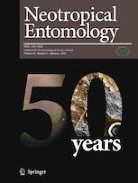Ver ítem
- xmlui.general.dspace_homeCentros e Institutos de InvestigaciónCICVyA. Centro de Investigación en Ciencias Veterinarias y AgronómicasInstituto de Microbiología y Zoología AgrícolaArtículos científicosxmlui.ArtifactBrowser.ItemViewer.trail
- Inicio
- Centros e Institutos de Investigación
- CICVyA. Centro de Investigación en Ciencias Veterinarias y Agronómicas
- Instituto de Microbiología y Zoología Agrícola
- Artículos científicos
- Ver ítem
Midgut Genes Knockdown by Oral dsRNA Administration Produces a Lethal Effect on Cotton Boll Weevil
Resumen
The “cotton boll weevil” (Anthonomus grandis Boheman) is a key pest in America whose larval stage develops within the cotton flower bud. During its development, the larva uses the flower bud as food and as a shelter from predators. This behavior limits the effective control through conventional insecticide applications and biocontrol techniques. Increasing genetic information from insects has allowed the development of new control technologies based on
[ver mas...]
The “cotton boll weevil” (Anthonomus grandis Boheman) is a key pest in America whose larval stage develops within the cotton flower bud. During its development, the larva uses the flower bud as food and as a shelter from predators. This behavior limits the effective control through conventional insecticide applications and biocontrol techniques. Increasing genetic information from insects has allowed the development of new control technologies based on the use of RNA interference (RNAi) to design orally delivered double-stranded RNA (dsRNA) strategies. In this study, we evaluated the effect of continuous oral administration of six specific dsRNA in order to identify an effective target gene for RNAi-mediated control of cotton boll weevil. First, six selected A. grandis gene fragments were amplified and cloned to perform in vivo synthesis of the specific dsRNA, and subsequently, larvae and adults were fed with this dsRNA for 2 weeks. Larvae mortality ranged from 40 to 60% depending on the targeted gene sequence. Indeed, α-amylase and cytochrome p450 dsRNAs were the most effective. Oral administration in adults caused smaller but still significant death rates (15–30%). Thus, the results demonstrated RNAi responses depend on life stages and target genes. The dsRNA ingestion was capable of providing knockdown mRNA levels in cotton boll weevil midgut and this effect was significantly higher in the larval stage. In this study, we present a new report of silencing of midgut genes in A. grandis larva induced by continuously feeding with dsRNA. This potential new tool should be further evaluated in cotton boll weevil control strategies.
[Cerrar]

Fuente
Neotropical Entomology 50 : 121-128 (Febrero 2021)
Fecha
2021-02
Editorial
Springer
ISSN
1678-8052
Formato
pdf
Tipo de documento
artículo
Palabras Claves
Derechos de acceso
Restringido
 Excepto donde se diga explicitamente, este item se publica bajo la siguiente descripción: Creative Commons Attribution-NonCommercial-ShareAlike 2.5 Unported (CC BY-NC-SA 2.5)
Excepto donde se diga explicitamente, este item se publica bajo la siguiente descripción: Creative Commons Attribution-NonCommercial-ShareAlike 2.5 Unported (CC BY-NC-SA 2.5)


